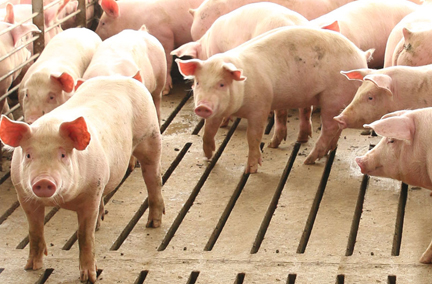
SHIC, launched by the National Pork Board in 2015 solely with Pork Checkoff funding, continues to focus efforts on prevention, preparedness, and response to novel and emerging swine disease for the benefit of US swine health. As a conduit of information and research, SHIC encourages sharing of its publications and research. Forward, reprint, and quote SHIC material freely. SHIC is funded by America’s pork producers to fulfill its mission to protect and enhance the health of the US swine herd. For more information, visit http://www.swinehealth.org or contact Dr. Sundberg at [email protected].

On March 29, 2022, the Swine Health Information Center and American Association of Swine Veterinarians hosted a webinar focused on the recent outbreak of Japanese encephalitis virus in pigs and people in Australia. Veterinarians from Australia along with US-based experts shared field experience, epidemiology, and potential risks for transboundary introduction of JEV into the US. The webinar offered a snapshot of the current situation and provided information to improve the identification and management of an unexpected outbreak. SHIC remains attentive to emerging swine disease issues around the globe to inform the US pork industry for better preparedness and response activities; 183 participants from 21 countries joined the webinar live.
Dr. Kirsty Richards, a veterinarian with the SunPork Group in Australia, shared background information on JEV in their country during the SHIC/AASV webinar. A flavivirus, JEV is in the same family as West Nile virus, St. Louis encephalitis virus, and Murray Valley encephalitis virus. The virus is maintained in a cycle between mosquitoes and vertebrate hosts, mainly ardeid birds such as herons, egrets, and bitterns. There is spillover of JEV to other species including pigs, humans, horses, and other domestic animals. Humans and horses are considered dead-end hosts because they usually do not develop high levels of viremia, while pigs are an amplifying host. Dr. Richards noted human cases have been diagnosed, with some mortalities, in Australia as well as cases of reproductive and neurological disease in pig herds.
In February 2022, JEV genotype 4 was identified in New South Wales, Victoria, Queensland, and South Australia. As of March 29, 2022, more than 50 pig farms across the eastern seaboard of Australia and in South Australia were diagnosed with JEV. Dr. Richards said, as of March 29, 2022, there have been 22 confirmed JEV cases in humans spread across the same geography in Australia. There are also 13 probable cases. (UPDATE: As of March 31, the Australian Government/Department of Health is reporting 34 human cases, 24 confirmed and 10 probable.)
Dr. Richards said Australia is addressing the outbreak with a one health approach, combining human and animal response protocols. Current activities at infected premises include mosquito trapping and control, vaccination of people working at and residing on those premises, and risk-assessed movement of pigs and semen.
Dr. Richards’s colleague at the SunPork Group, Dr. Bernie Gleeson, shared clinical and pathological findings reported at the JEV-affected farms. They have observed apparently healthy sows with abortions and delayed farrowing, greater than 118 days. Aborted litters had fetuses with domed heads, subcutaneous oedema, ascites, and arthrogryposis. Necropsy of aborted piglets revealed the absence of forebrain, hindbrain, and cerebellum. Some affected piglets born alive were shaky with poor survival.
Dr. Leela Noronha, with the Foreign Arthropod-Borne Animal Disease Research Unit at USDA’s National Bio and Agro-Defense Facility, in Manhattan, Kansas, said the US has the necessary components for JEV transmission – competent insect vectors and susceptible vertebrate maintenance and amplifying hosts. Concern over JEV is based in part on the precedent set by West Nile virus which grew exponentially since being introduced in 1999. However, there is no active surveillance in US for JEV at this time. JE is a reportable disease in the US.
Insect vectors of JEV are numerous though it is primarily transmitted by Culex spp. mosquitoes. In experimental conditions, a few North American Culex species and others have been shown to be competent insect vectors. Avian hosts of JEV can serve as mobile virus reservoirs which are typically asymptomatic. Dr. Noronha said wild and domestic North American species have demonstrated susceptibility experimentally.
JEV-affected swine play an important role in virus amplification. Wild pigs are wildcards that can impact transmission given they represent a rapidly expanding, free-range population of vertebrate hosts.
Experience shows that clinical presentation in swine varies by age and prior exposures. In adult swine, JE is primarily a reproductive disease, though affected adults may present with nonspecific transient febrile illness. Sows can exhibit abortion, stillborn, fetal mummification, or subsequent production of weak piglets. Boars exhibit orchitis and infertility. In piglets, non-specific signs and wasting are evident as are neurologic disease and high mortality.
Dr. Natalia Cernicchiaro, Kansas State University, presented information on the risk of introduction of JEV in the continental US. Maps illustrated the global expansion of JEV from Asia to northern Europe to Africa where competent vectors and hosts exist. The fact that the US shares similar climate and environmental conditions with countries where JEV is epidemic and has competent vectors and hosts as well as increased travel and trade from and to JEV-affected regions since World War II, along with the fact that there is no active JEV surveillance program in the US, make this region susceptible to a JEV incursion.
Dr. Cernicchiaro and a team of experts have conducted a qualitative and quantitative risk assessment addressing the likelihood of JEV reaching the US. This risk assessment addressed:
In the study, aircraft and cargo ships emerged as the most likely pathways of introduction for JEV via infected adult mosquitoes. The probability of introduction of JEV through infected adult mosquitoes via aircrafts was deemed very high whereas the probability of entry via ships/containers was considered of low to moderate risk. Although the probability of transmission was deemed of variable risk, from low to high, depending on the US area of introduction and the season, under current conditions, the probability of JEV establishment in the US is considered negligible because of the low availability of amplifying hosts (pigs) and the limited contact rates between infected mosquitoes and hosts in airports and seaports, areas at high risk of introduction of infected vectors. Given the study findings, prevention and control should be directed towards the aircraft pathway and include aircraft disinfection in the countries of origin, or when arriving at the destination. Dr. Cernicchiaro also said the study results point to active surveillance programs on the east and west coasts of the US as being warranted.
SHIC, launched by the National Pork Board in 2015 solely with Pork Checkoff funding, continues to focus efforts on prevention, preparedness, and response to novel and emerging swine disease for the benefit of US swine health. As a conduit of information and research, SHIC encourages sharing of its publications and research. Forward, reprint, and quote SHIC material freely. SHIC is funded by America’s pork producers to fulfill its mission to protect and enhance the health of the US swine herd. For more information, visit http://www.swinehealth.org or contact Dr. Sundberg at [email protected].

The Swine Health Information Center-funded Domestic Swine Disease Reporting System shares information on endemic and emerging diseases affecting domestic swine via monthly reports, dynamic online dashboards, SwineCast, LinkedIn, YouTube channel, and podcasts. With the addition of data on influenza A virus in April 2022, the 50th monthly report, the three most relevant swine respiratory etiologies – IAV, porcine reproductive and respiratory syndrome, and Mycoplasma hyopneumoniae – are all included. SDRS also includes data on porcine epidemic diarrhea virus, porcine deltacoronavirus, and transmissible gastroenteritis virus.
SDRS, developed in a collaborative project with data from Iowa State University, University of Minnesota, South Dakota State University, Kansas State University, and Ohio Animal Disease Diagnostic Lab, is currently the only publicly available source of swine health information from veterinary diagnostic labs. SDRS reports contain information aggregated from participating VDLs, providing data to assist veterinarians and producers in making informed decisions on disease prevention, detection, and management.
After aggregating information from participating VDLs on all viruses being monitored and summarizing the data, the input of the SDRS advisory group which consists of veterinarians and producers across the US swine industry is included. The intent is to provide an interpretation of the observed data and summarize the implications to the industry. The advisory group identified IAV, one of the major respiratory pathogens affecting the swine industry, as a gap in reporting due to its role as an element of the porcine respiratory disease complex.
The SDRS team and participating VDLs agreed with SHIC providing additional funding for incorporating IAV data. Now a database of information on IAV is initiated and moving forward; influenza subtyping information will also be incorporated in the report. Reports are published on the first Tuesday of each month on the SDRS website, sent to those who subscribe to the reports (send subscription request to [email protected]), and included in the SHIC newsletter (subscribe here). The website dashboard is updated daily, a real-time data source.
SDRS reports are the result of a VDL data standardization project SHIC supported. The SDRS model describes dynamics of disease detection by pathogen over time, specimen, age group, farm type, and geographical space. The report provides benchmark comparison data, providing tools for detecting trends, regionalization, and understanding how to react to outbreaks. The SDRS is the only source of information on active pathogens in all phases of production including the breeding and grow-finish segments. The SDRS team welcomes input for the report, which keeps evolving based on input from the industry and the advisory group since it was initiated in 2017.

In research funded by the Swine Health Information Center (SHIC) and conducted at Kansas State University, two feed mills and three breed-to-wean facilities diagnosed with porcine deltacoronavirus (PDCoV) were investigated for possible connections related to the outbreak. Initial suspicion was feed manufacture and delivery processes were involved in disease transmission. Goals of the research were to understand if the feed mill was the origin of disease and then determine if trucks or people, either coming from the infected farms or coming from the feed mills, served as vectors to spread this virus.
Both feed mills were audited and environmental samples collected in areas deemed high risk for virus contamination. All breed-to-wean facilities had PDCoV detected as would be expected, while the only positive samples for enteric coronaviruses associated with feed mills were feed delivery trucks.
This diagnostic investigation did not find evidence within the feed supply chain indicating feed or feed delivery was associated with outbreaks of PDCoV. Due to the nature of timing, it is believed that the contamination identified at the infected sites was due to the intentional exposure through controlled oral exposure. Furthermore, it is not known what the specific mechanism of transmission was to these farms, although other routes must be considered such as personnel and other possible fomites such as incoming supplies. The goal of this investigation was to evaluate the likelihood of a link between feed manufacturing and delivery with the outbreak of clinical disease, so greater investigation into potential routes of entry were not explored.
This investigation highlights the importance of biosecurity during controlled oral exposure because viral contamination can be detected outside of the farm perimeter and common events such as feed delivery may serve as a mechanism for transfer of viral contamination back to the feed mill or to other farms. The current investigation emphasizes the importance of biosecurity in the feed supply chain at both the feed manufacturing and delivery stages, with particular focus needing to be directed towards personnel movement.

The Swine Heath Information Center has updated its porcine circovirus 3 Fact Sheet and begun a project with Iowa State University and the University of Minnesota to investigate historical submissions, tests, and tissues, with their available clinical signalment, to help lead to an applicable US case definition. An analysis of historical submission tests/clinical signs at UMN has already been done and will add to the case definition development. The laboratory analyses will help lead to standardized diagnostic criteria and when the case definition is finalized, on-farm epidemiological work will begin later in 2022.
PCV3 is an emerging pathogen of swine with potential economic importance, per SHIC’s updated PCV3 Fact Sheet. It has been associated with signs similar to those caused by PCV2. However, many infections seem to be subclinical, and PCV3 pathogenicity studies have had mixed results. PCV 3 has been associated with neurological disease, reproductive failure, respiratory disease, enteric disease, and porcine dermatitis and nephropathy syndrome. However, only a few studies have demonstrated the presence of PCV3 in lesions.
Both PCV2 and PCV3 spread through vertical and horizontal transmission. Virus is shed in most secretions and excretions. Direct contact is the route of most significance but spread can also occur via fomites and ingestion. PCV3 is found in wild and domestic pigs. Antibodies to PCV3 have been detected in dogs, cattle, and mice. PCV3-positive mosquitoes have been found. Wild ruminants and ticks may also be reservoirs.
PCV3 is found in many swine-producing regions of the world. Epidemiological studies have found that infection is widespread, with prevalence up to 100%. Little is known about the course of natural infection. A few studies have shown that prevalence is highest in piglets/weaners and decreases with age, but PCV3 has been detected in pigs up to 23 weeks of age.
PCV3 belongs to the family Circoviridae. Members are very small, non-enveloped viruses with a circular, covalently closed, single-stranded DNA genome. While there are four recognized circoviruses of swine, designated PCV1–4, PCV3 is distinctly different from other PCVs and is closely related to canine and bat circoviruses.
PCV1 was identified in 1974 as a contaminant in a pig kidney cell line. In 1997, PCV2 was recognized as the cause of a novel wasting disease affecting Canadian pigs. In 2016, PCV3 was detected in tissues from sows from North Carolina that died acutely with PDNS-like clinical signs and aborted fetuses. PCV4 was discovered in samples from pigs with respiratory disease, enteric disease, and PDNS in China in 2019.

This month’s Domestic Swine Disease Monitoring Report brings onboard Influenza A virus RNA detection by RT-PCR data from all five participating veterinary diagnostic labs with a historical summary highlighted on the SDRS bonus page. There was increased activity of PRRSV at a regional level in some particular areas, i.e., Missouri, Nebraska, Illinois, and Indiana. PEDV activity is still above expected levels since the end of January. In the podcast, the SDRS hosts talk with Dr. Brigitte Mason, field veterinarian at Country View Family Farms, Dr. Paul Yeske, veterinarian and partner at Swine Vet Center, Dr. Phillip Gauger, head of the molecular section at ISU-VDL, and Dr. Tara Donovan, leader of the health assurance team at Hanor Company, about recent advancements in PRRSV management, strategic FAD surveillance, low-hanging fruits in biosecurity, and how to take full advantage of diagnostic data for animal health decision making.

Read about the first major outbreak of JEV in Australia in the April Global Swine Disease Monitoring Report. AFS outbreaks continue in The Dominican Republic with more than 1,150 confirmed so far. The report also contains information on US Customs and Border Protection seizures of meat products from China as well as entry of illegal products in Texas. A technical report on the ability of ASFV to remain viable in different matrices is also included.
Copyright 2025 | Swinehealth.org | Website by Heartland Marketing Group